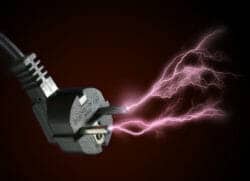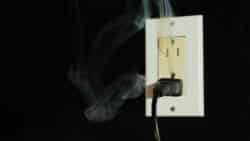Sparks When Plugging Into An Outlet
Home » Electrical » Outlets & GFCI »

Electrical fires and getting shocked are a concern when there are sparks when you plug a cord into an outlet, especially when there are approximately 50,000 house fires, 450 deaths and $1.5 billion dollars of property damage a year.
Seeing sparks when plugging into an outlet is not uncommon and doesn’t always mean that there is serious electrical problem or a fire hazard. In reality there are more sparks or arching then we visibly see. This is not to say that there are not times to be concerned about the sparking and the possibility of a fire or shock.
In general, you will see more sparking in older homes than new ones, but even new ones may have this issue in some cases. Interestingly, even the way you plug a cord or an appliance into an outlet can determine if you see a spark. If you have the plug at rather crooked angle when you start to plug the plug in, you may get a little sparking.
Serious warning signs

There are a number of warning signs, include the following:
- Smoke odors
- Visible smoke
- Warm or hot outlets
- Warm or hot wiring or appliance plugs
- Wall feels warm or hot
- Sparking every time the outlet is used
- Sparks lasting longer than a fraction of a second
- Buzzing or humming sounds
- Paint on outlet that has gotten into the outlet slots
- Burn marks and stains on outlet
- Tripping of a breaker (or a fuse blows) when you plug in an appliance
Causes of sparking (arcing)
Plugging in an appliance that is in the on position
When you’re plugging an appliance that is in the ON position, as the plug gets closer to the outlet slots, the power tries to jump from the outlet to the prongs of the plug. In less than a split second the electricity creates a spark and heat. This is referred to as arcing and is a common occurrence which we often don’t even see.
Plugging and unplugging of appliances cords
The plugging and unplugging of an electric cord results in metal parts rubbing; the plug prongs rub the outlet slots. This action is like a metal file slowly wearing down the metal parts of the outlet. Eventually the connection between the plug and outlet becomes loose and the plug just falls out of the outlet. At times we might try to bend the plugs’ prongs a little to get it to stay in the outlet and not fall out, however this is a poor solution. Replacing the outlet, the plug or both is a much safer solution. These worn outlets are prone to arcing and then we see the sparking. Basically, the sparking we see is actually called arcing by electricians.
Loose connections
When electricity runs through a wire (copper or aluminum), the wire expand due to the flowing electricity creating heat and when off, the wire contracts. This continual expansion and contraction over the year’s results in wiring connections becoming a little loose; these loose connections may result in arcing.
Outlet damaged
If an outlet is damaged then there may be metal components that are not properly insulated or bent and this may create a short circuit which then results in sparking.
Dust and debris
Outlets that have debris in the slots or even heavy dust may prevent a solid connection between the plugs’ prongs and the outlet slots. Should these connections not be full and tight connections, then arcing may occur.
Animals or mice
When an animal or a mouse chews through the insulation on a wire, especially on several wires close to each other or a wire close to a metal junction box; then arching may occur.

Other related issues
Wiring Age
Wiring ages and as power runs through the wiring it gets warmer, if too much power, it over heats. Over the years, wiring getting warm and then cooling takes its toll on the insulation, the insulation eventually becomes brittle, develops cracks and may fall off of the wiring. Once the insulation is damaged, then arcing may occur. Arcing produces tremendous heat, just like lightening, and this can cause a fire in walls with wood studs or other combustionable materials.
Wiring undersized for breaker and load
Under-sized wiring for the current being carried can also cause heat build-up in wiring and results in the insulation melting, cracking or malfunctioning. Wiring undersized for the breaker and the load its carrying is a serious fire safety concern.
Over loaded circuit
Homes electrical circuits may have a number of outlets on them, at times too many for one circuit. If a homeowner connects too many appliances, especially ones that have a big electrical draw onto one circuit or outlet, it may create excessive heating of the wires, resulting in damage to the insulation; this may result in arcing or even a fire.
Appliances with big power draws include space heaters, micro-waves, hair blow dryers, toasters, etc.
Note that overloaded circuits, damaged insulation, and arcing can also cause smoke and burn marks on an outlet or the cover.
Adding AFCI Breakers greatly improves outlet safety for preventing fires
There are AFCI breakers and outlets that are designed to trip (shut off the power) when they sense arcing. When arcing occurs there is a tremendous amount of heat ( i.e. 2,400 to over 10,000 degrees Fahrenheit) that is generated; this heat can cause a fire. Wood studs and other flammable materials are easily set afire when arcing occurs. Changing out old breakers with AFCI breakers provide a much higher level of fire protection for a home. (Read about AFCI breakers and outlets)

Check to see if there are operating smoke detectors
Having operating smoke detectors and carbon monoxide alarms are also great devices to save lives in a home. Read more about:
- Where to put smoke detectors
- 11 places NOT to put smoke detectors
- Where to put carbon monoxide alarms
Facts
The U.S. Fire Administration (USFA) reports that electrical issues are the 3rd most common reason for house fires. 60% of fire deaths occur in homes with smoke detectors that aren’t working of there is none in the home.
In less than 30 seconds a small flame can erupt into a major fire
You may have only have two, three or four minutes to escape.

Bottom Line
- It is not unusual for there to be sparking at an outlet when you plug into it and there are many times you can’t even see the sparking.
- Replacing an outlet and making sure all wiring is well connected will solve many sparking issues.
- Making sure that the appliances you plug in are on the “OFF” position will prevent sparking much of the time.
- Sparking can be serious under some condition and a qualified electrician should be obtained to check and correct any problems. Shutting the power off to a sparking outlet and unplugging the connected appliance is wise when the problem is serious.
- Don’t overload electrical circuits with too many appliance connected or ones with high power usage.
Do you have answers for the following questions?




if one of the 2 plugs in a duplex recepticale is burn mark or melted a little, is it ok to use the undamaged plug of the 2